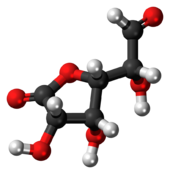Chemistry:Glucuronolactone

| |

| |
| Names | |
|---|---|
| IUPAC name
D-Glucurono-6,3-lactone
| |
| Systematic IUPAC name
(2R)-2-[(2S,3R,4S)-3,4-Dihydroxy-5-oxo-tetrahydrofuran-2-yl]-2-hydroxy-acetaldehyde | |
| Other names
Glucuronic acid lactone; Glucurone; Glucurolactone (INN); D-glucurono-gamma-lactone; glucurono-γ-lactone
| |
| Identifiers | |
3D model (JSmol)
|
|
| ChemSpider | |
PubChem CID
|
|
| UNII | |
| |
| |
| Properties | |
| C6H8O6 | |
| Molar mass | 176.124 g·mol−1 |
| Density | 1.76 g/cm3 (30 °C) |
| Melting point | 176 to 178 °C (349 to 352 °F; 449 to 451 K) |
| 26.9 g/100 mL | |
Except where otherwise noted, data are given for materials in their standard state (at 25 °C [77 °F], 100 kPa). | |
| Infobox references | |
Glucuronolactone or Glucurolactone (INN) is a naturally occurring substance that is an important structural component of nearly all connective tissues.[1] It is sometimes used in energy drinks.[2][3] Unfounded claims[4] that glucuronolactone can be used to reduce "brain fog"[5] are based on research conducted on energy drinks that contain other active ingredients that have been shown to improve cognitive function, such as caffeine. Glucuronolactone is also found in many plant gums.[1]
Physical and chemical properties
Glucuronolactone is a white solid odorless compound, soluble in hot and cold water. Its melting point ranges from 176 to 178 °C.[1] The compound can exist in a monocyclic aldehyde form or in a bicyclic hemiacetal (lactol) form.
 Lactol form of glucuronolactone
Lactol form of glucuronolactone
History
It is unknown if glucuronolactone is safe for human consumption due to a lack of proper human or animal trials. However, it likely has limited effects on the human body.[6] Furthermore research on isolated supplements of glucuronolactone is limited, no warnings appear on the Food and Drug Administration website regarding its potential to cause brain tumors or other maladies.[4][7]
Uses
Glucuronolactone is an ingredient used in some energy drinks[2] Although levels of glucuronolactone in energy drinks can far exceed those found in the rest of the diet. Research into Glucuronolactone is too limited to assert claims about its safety[8] The European Food Safety Authority (EFSA) has concluded that it is unlikely that glucurono-γ-lactone would have any interaction with caffeine, taurine, alcohol or the effects of exercise. The Panel also concluded, based on the data available, that additive interactions between taurine and caffeine on diuretic effects are unlikely.[6]
According to The Merck Index, glucuronolactone is used as a detoxicant.[9]
Glucuronolactone is also metabolized to glucaric acid, xylitol, and L-xylulose, and humans may also be able to use glucuronolactone as a precursor for ascorbic acid synthesis.[10]
Glucuronolactone is approved in China and Japan as an over-the-counter "hepatoprotectant",[11][12][13] though there is a conspicuous lack of systematic reviews on this use.[14]
See also
References
- ↑ 1.0 1.1 1.2 1.3 Merck Index, 11th Edition, 4362
- ↑ 2.0 2.1 "V Energy" (in en). https://v.co.nz/products/v?.
- ↑ Rahnama, Nader; Gaeini, Abbas Ali; Kazemi, Fahimeh (2010). "The effectiveness of two energy drinks on selected indices of maximal cardiorespiratory fitness and blood lactate levels in male athletes". Journal of Research in Medical Sciences 15 (3): 127–132. ISSN 1735-1995. PMID 21526071.
- ↑ 4.0 4.1 "Does Glucuronolactone Boost Energy? Benefits vs. Dangers" (in en-US). 2019-12-05. https://selfhacked.com/blog/glucuronolactone/.
- ↑ "Glucuronolactone Benefits & Safety in Red Bull Energy Drinks" (in en-US). 2015-12-10. https://nootriment.com/glucuronolactone/.
- ↑ 6.0 6.1 "The use of taurine and D-glucurono-gamma-lactone as constituents of the so-called "energy" drinks" (in en). EFSA Journal 7 (2): 935. 2009. doi:10.2903/j.efsa.2009.935. ISSN 1831-4732.
- ↑ "Bull Marketed". Snopes.com. 21 January 2013. http://www.snopes.com/medical/potables/redbull.asp.
- ↑ "Glucuronolactone: Uses, Side Effects, Interactions, Dosage, and Warning" (in en). https://www.webmd.com/vitamins/ai/ingredientmono-1624/glucuronolactone#.
- ↑ Merck Index, 14th ed., 4467
- ↑ "Effect of D-glucuronic acid and D-glucuronolactone on ascorbic acid levels in blood and urine of man and dog". Am J Clin Nutr 8 (3): 369–73. 1960. doi:10.1093/ajcn/8.3.369. PMID 13795987.
- ↑ "KEGG DRUG: Glucuronolactone". https://www.genome.jp/entry/D01800.
- ↑ Beijing Taiyang Pharamaceuticals. "Error: no
|title=specified when using {{Cite web}}". https://yp.120ask.com/detail/9391.html. "OTC 甲类、医保乙类 [OTC drug class A, national health insurance drug list class B] [...]" - ↑ Yu, Z; Wu, F; Tian, J; Guo, X; An, R (September 2018). "Protective effects of compound ammonium glycyrrhizin, L‑arginine, silymarin and glucurolactone against liver damage induced by ochratoxin A in primary chicken hepatocytes.". Molecular medicine reports 18 (3): 2551-2560. doi:10.3892/mmr.2018.9285. PMID 30015927.
- ↑ "NCATS Inxight Drugs — GLUCUROLACTONE" (in en). https://drugs.ncats.io/drug/XE4Y3016M9.
 |

